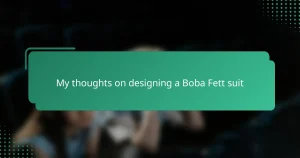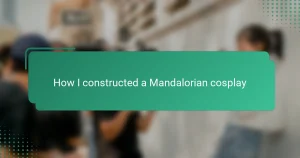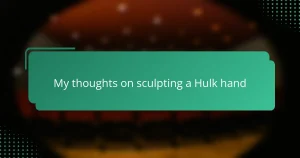Key takeaways
- Science fiction props blend creativity and practicality, enhancing storytelling through design and materials.
- Key materials for sci-fi costumes include lightweight fabrics and unexpected elements to achieve the desired futuristic look.
- Layering, bold accessories, and attention to detail are crucial for creating authentic and visually appealing outfits.
- Experiencing the outfit firsthand reveals insights that improve the overall design and functionality, making it feel alive.

Understanding Science Fiction Props
Science fiction props are more than just objects; they are gateways to another world. When I first started studying these props, I was amazed at how every detail, from materials to design, serves a storytelling purpose. Have you ever wondered why a simple gadget feels so futuristic yet believable?
For me, understanding science fiction props means appreciating their blend of creativity and practicality. They challenge the imagination while grounding the story in a sense of reality. This balance is what makes them so captivating and inspirational for anyone looking to create an authentic outfit or replica.
In crafting a Back to the Future outfit, I realized that truly grasping what defines a science fiction prop pushed me to look beyond aesthetics. It became about capturing the essence and innovation behind each piece, which brought the whole costume to life in a way I hadn’t expected.
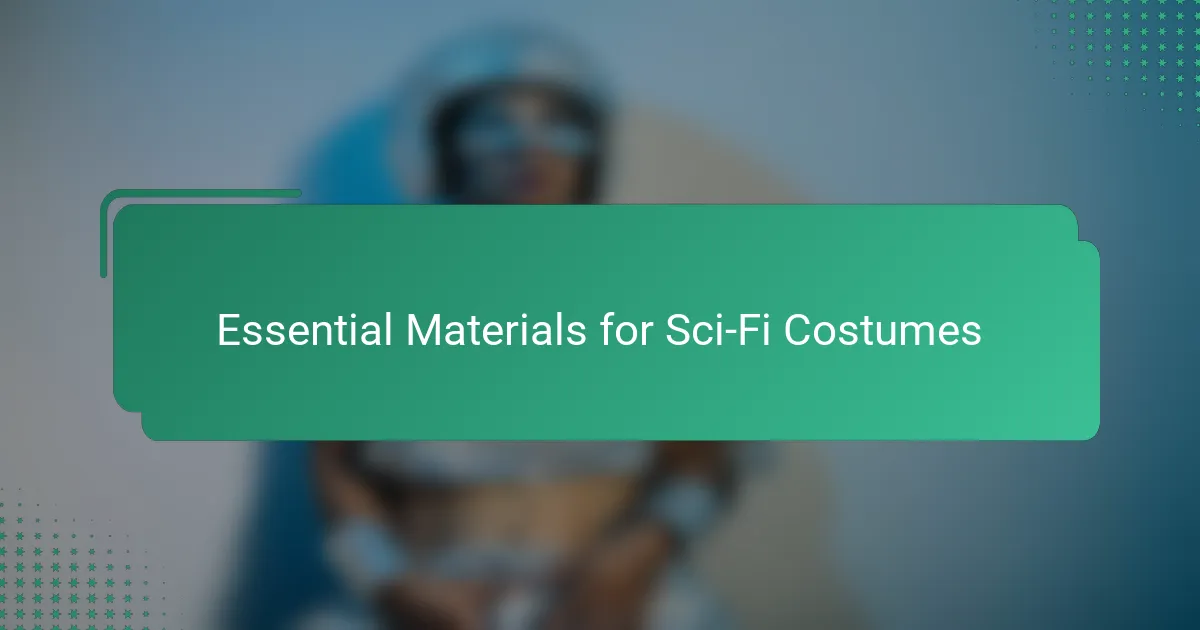
Essential Materials for Sci-Fi Costumes
When I started gathering materials for my Back to the Future outfit, I quickly learned that choosing the right fabrics and components is half the battle. Lightweight, synthetic fabrics like nylon or polyester give that futuristic sheen and durability, essential for sci-fi costumes that often need to look high-tech yet wearable. Have you ever tried working with materials that just don’t hold up or look right on camera? It’s frustrating and a real eye-opener.
I also discovered that combining unexpected elements—like foam, plastic panels, and metallic paints—can transform a simple piece of clothing into something that feels straight out of a time machine. Using these materials allowed me to experiment with textures and shapes, which made the costume not just accurate but alive with detail. It was like giving the outfit its own character, something more than just fabric.
Reflecting on it, the key for me was not just picking expensive or complicated materials but finding those that worked together in harmony. Have you noticed how some sci-fi costumes seem overwhelming or clunky? That’s usually because the materials don’t blend well. In my experience, a thoughtful balance brought my outfit to life and made every element feel purposeful.
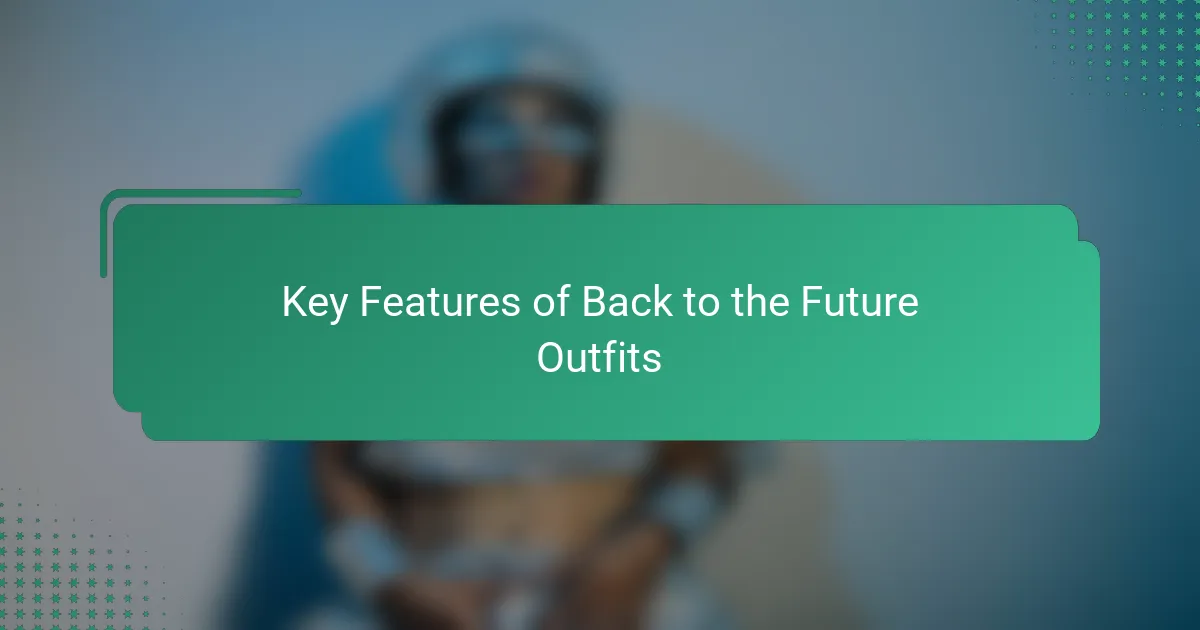
Key Features of Back to the Future Outfits
One thing that stood out to me about Back to the Future outfits is their clever mix of retro and futuristic elements. For example, Marty McFly’s iconic red puffer vest over a flannel shirt isn’t just a random choice—it instantly signals a specific time period while hinting at something out of the ordinary. Have you ever noticed how this blend makes the outfit feel both familiar and ahead of its time? That tension is what gives these costumes their lasting appeal.
Another key feature is the use of bold accessories that almost become characters themselves. The self-lacing Nike shoes, though fictional at the time, act as a symbol of technology advancing beyond our imagination. When I built my version, adding these details made me realize how small elements can carry a huge amount of story and personality. It’s like the outfit isn’t just worn—it talks.
Finally, I can’t overlook the importance of layering in these costumes. Multiple textures and pieces stacked perfectly create a look that’s casual yet detailed enough to catch the eye. Have you ever tried recreating that carefully balanced look? It took me a few attempts to get it right, but once I did, the outfit truly snapped into place. That layering adds depth, making the costume more than just a copy but a lived-in piece of sci-fi history.

Step-by-Step Outfit Creation Process
Starting the outfit, I broke the whole look down to its core elements—shoes, vest, shirt, and accessories—and tackled each one methodically. I remember obsessing over the vest first; it had to have that perfect puffy look without feeling bulky or fake, so I experimented with different stuffing materials until it looked just right. Have you ever had that moment when something almost works, but not quite? That’s when you know you’re close.
Next came the layering, which felt like assembling a puzzle where every piece must fit visually and physically. I tried on the flannel shirt over various undershirts to get the right texture and color balance, discovering that subtle tweaks here changed the whole vibe. For me, this stage was about patience and letting the layers speak for themselves—sometimes less is more, even in sci-fi.
Finally, the details made all the difference. Adding the self-lacing shoe effect with cleverly hidden Velcro and painting tiny metallic accents on the vest’s zipper pulled everything into focus. I found myself stepping back, grinning as the outfit finally felt like the iconic Marty McFly look—authentic, alive, and ready for its own adventure. Have you noticed how the smallest detail can transform a costume from good to unforgettable? That was exactly my experience.

Tips for Authentic Prop Detailing
Getting the details right is what turns a good sci-fi prop into something truly believable. When I worked on my Back to the Future outfit, I realized that tiny touches—like weathering a prop to mimic wear or adding subtle metallic highlights—make a huge difference. Have you ever held a prop and thought, “This looks too new”? That’s usually a sign it needs more authentic wear or nuanced paintwork.
I also found that studying close-up photos and screen captures helped me catch details I might’ve missed otherwise. It’s amazing how a small label, a stitch pattern, or a thoughtfully placed scratch can add layers of realism. When I replicated those, it felt like I was not just copying but breathing life into the piece.
One trick I swear by is using mixed media and layering different materials and textures. It’s not just about visual accuracy but about how the piece feels in your hands and to the eye. For instance, combining soft fabrics with hard plastic parts gave my outfit the right contrast, making it pop just like the original. What’s a detail you never thought mattered until you saw it in the original prop? That’s where authenticity truly lives.

Personal Challenges and Solutions
One of the hardest challenges I faced was replicating Marty’s vest without it looking like a bulky Halloween costume. I remember wrestling with different stuffing materials, trying to find that perfect puffiness that felt real but not overdone. It was frustrating at times—have you ever hit that point where your creation looks almost right but just not quite? That’s when I learned patience is key.
Another hurdle was capturing the worn-in feel of the clothes and accessories. At first, my outfit looked too pristine, like it had just come off a store shelf. Adding subtle weathering, like faint scuffs and soft metallic touches, made all the difference. I realized that authenticity isn’t just about matching colors but about telling a story through every little imperfection.
Lastly, coordinating all the materials to work together without clashing was surprisingly tricky. Mixing soft fabrics with plastic panels and metallic paints could easily have felt overwhelming. It took some trial and error to strike a harmonious balance—sometimes less really is more. Did you ever find yourself pulling pieces apart and putting them back together just to get the right feel? That process, though challenging, ended up being incredibly rewarding.
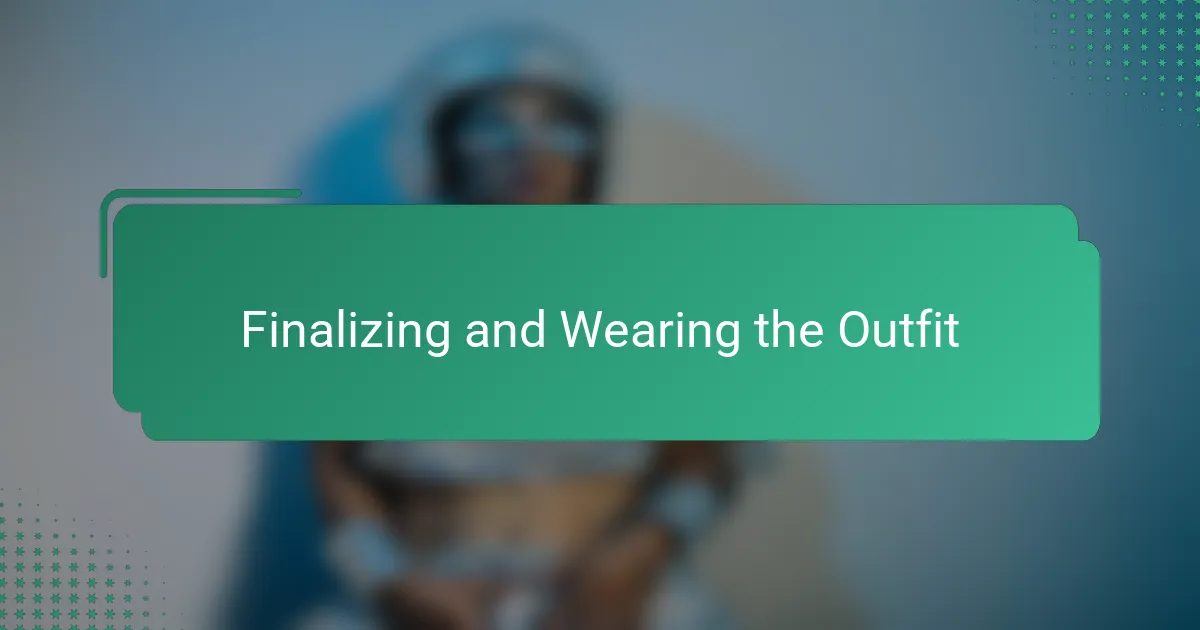
Finalizing and Wearing the Outfit
Putting the final touches on the outfit was both thrilling and nerve-wracking. I remember that moment slipping on the vest and realizing it had the right puff and texture—not too stiff, not too floppy. Have you ever tried on something you built yourself and felt that instant connection? That’s when all the hours of tweaking finally pay off.
Wearing the complete outfit brought an unexpected sense of pride. I found myself adjusting the layers, making sure the flannel and vest sat just right, and feeling how the accessories added character without overwhelming the look. It’s funny how something you imagined for so long suddenly feels real—and it made me appreciate the care that went into the original design even more.
I also noticed that moving around in the costume gave me new insights, like how the vest’s padding shifted or how the shoes felt with every step. Have you ever discovered small flaws or improvements only after wearing your creation? That hands-on experience helped me see the outfit not just as a replica but as something alive, ready for its own sci-fi adventure.
